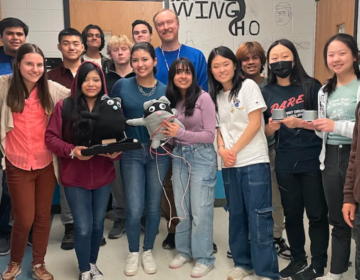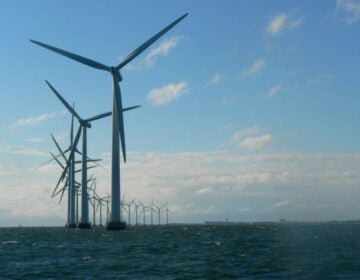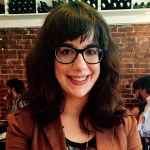New Jersey girls find a voice and mentors at Princeton Plasma Physics Lab STEM conference
Listen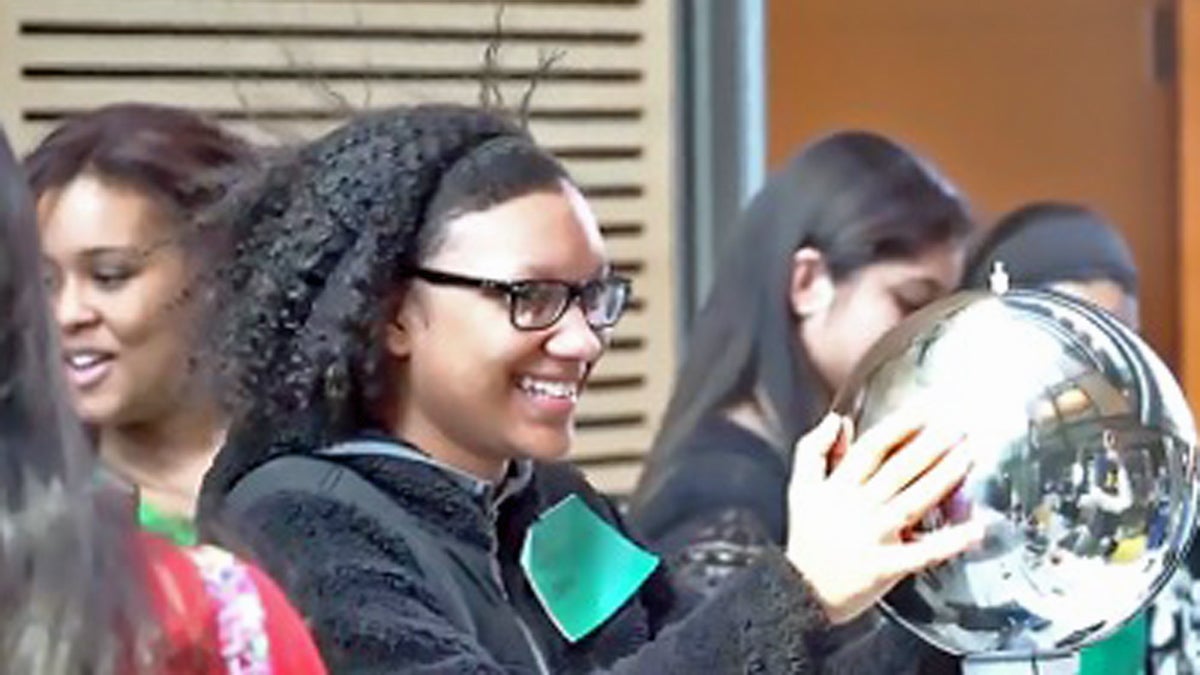
Ciera Matlock, a student from Linwood Middle School in North Brunswick tries out a Van de Graaff generator at PPPL’s display. (Photo courtesy of Elle Starkman/PPPL Office of Communications)
It was a loud, busy day. Nearly 600 middle- and high-school girls filled the ground floor of Princeton University’s Frick Chemistry Laboratory. They lit bubbles on fire, dug into evidence with the F.B.I., and watched super-fast cameras in action.
It was the15th annual Young Women’s Conference in Science, Technology, Engineering, and Mathematics (STEM) a long-time project of the Princeton Plasma Physics Laboratory (PPPL), a Department of Energy plasma physics and fusion research facility.
Over 30 science booths, break-out groups, and speakers were packed into the conference schedule. Above the chatter, the music of steel drums echoed around the room — part of an exhibit by the Cultural Academy for Excellence in Mount Rainier, Maryland that explained the “physics of sound.”
Dorothy Brussel, a 12-year-old from Matawan Aberdeen Middle School, noticed the “Physics of Sound” exhibit right away.
“One of the booths showed us how to turn an oil container into a steel drum. And I really wanted to try that. I did try it,” she said. “It was very cool to know that, depending on how deep the dent in the metal is, you can tune the sound of the note that you make.”
Brussel, who hopes to pursue a career in biomedical engineering, attended the PPPL’s Young Women’s Conference in STEM with nine other students from Matawan Aberdeen Middle School.
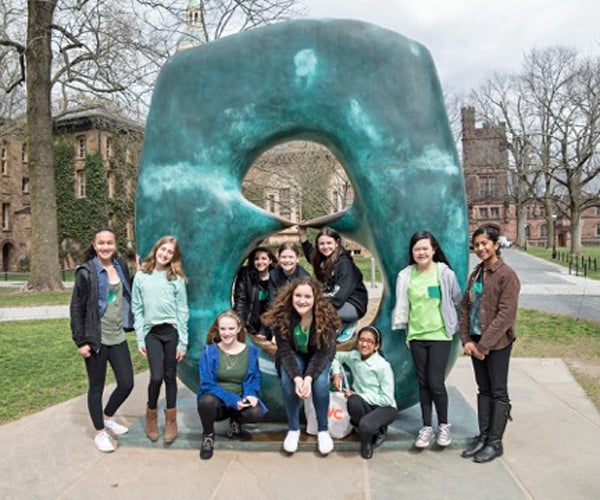 Science Teacher Patricia Hillyer and her students from Matawan-Aberdeen Middle School pose in front of a sculpture on the Princeton University campus. (Photo courtesy of Elle Starkman/PPPL Office of Communications)
Science Teacher Patricia Hillyer and her students from Matawan-Aberdeen Middle School pose in front of a sculpture on the Princeton University campus. (Photo courtesy of Elle Starkman/PPPL Office of Communications)
Classmate Bryn Reiser, who says she has “always wanted to go into science” and wants to pursue a career as a medical researcher, also enjoyed the steel drum exhibit. Like Brussel, it wasn’t only the music that caught her attention; it was the construction of the instruments themselves.
“I liked how they used something that people normally throw away,” said Reiser. “And you don’t really use it everyday life. But they turned it into something that people can use to make music, and just like play with, and have fun with — when usually, it would go to waste.”
“Unusual” to like science
Patricia Hillyer, their passionate and devoted teacher, has taught science at Matawan Aberdeen Middle School for 15 years. Hillyer has brought student groups to the PPPL’s Young Women’s Conference for four years, and encourages her students to video stream the PPPL’s “Science on Saturday” programming.
Hillyer says that the cause of “getting girls into science” is close to her heart. She remembers that when she was young, her father told her she was “unusual” because she loved science more than language arts or history. He told her “that’s not what girls usually do.” She wants her own students to feel differently about science.
Hillyer believes that negative gendered stereotypes can negatively impact and influence girls at a young age — even younger than the conference’s target participant age of seventh- to –tenth graders.
“I’d hate to have the 4th, 5th, 6th grade girls lose their interest and, you know, be intimidated by the line of well, the boys go into science, and the girls go into — language arts.”
Hillyer also said the event gives her students access to experiences that simply can’t be replicated in a classroom.
“This program is so important for these girls,” she said. “They get to see a university. They get to see what other women do. They get to see all of their options. They see how women interact with each other, and support each other, and build each other up.”
Deedee Ortiz, the Princeton Plasma Physics Laboratory’s Science Education program manager and conference organizer, said the goal of the conference is not only to inspire girls to love science — but to grow up as scientists one day. “One thing this program does is to inspire these girls to pursue a career in STEM,” she said.
Ortiz said that because the conference pairs young women with accomplished yet approachable scientists (who, in turn, become potential mentors and role models), the students begin to see a science careers as a true possibility. The PPPL’s conference, said Ortiz, makes a future in STEM “that much more real” for young women.
Shannon Greco, a Science Education program leader at the PPPL, said the conference gives girls the opportunity to “engage with real scientists and engineers” who have a knack for inspiring and educating young people. “The students see that science is people, not some abstract entity, solving the world problems,” said Greco. “It’s people, trying to understand the world’s mysteries.”
The Young Women’s Conference included opportunities for students to meet female scientists, researchers, and potential mentors. In the morning, a panel discussion led by the Association for Women in Science convened female science writers, neuroscientists, and researchers.
In breakout sessions, students attended research talks by Sophia Gershman, president of Advanced Research Innovations in Science Education, Inc. and a collaborator at the PPPL, and Kamana Misra, president of the central New Jersey chapter of the Association of Women in Science (AWIS). The keynote talk was given by Jin Kim Montclare, an associate professor of Chemical and Biomolecular Engineering at New York University’s Tandon School of Engineering.
“They really need to meet these women, and talk to them, and to be exposed to these science careers,” said Ms. Hillyer, who emphasized the importance of role models for girls, especially those who demonstrate an interest in science. “I hope that they will feel inspired, so that they can continue to become students of STEM.”
At Matawan Aberdeen Middle School, Hillyer is also a science (STEAM) club advisor. She says 67 students showed up to the first meeting this year. Only 5 were girls, and she’s trying to change that. Now, she says, roughly 15 girls participate regularly.
At the conference, some of her students said that they’ve noticed a difference in how boys and girls their age feel about science. But most of Hillyer’s students agreed with Alana Hill, 13, who said she she hasn’t noticed a difference between whether girls are more or less interested in science than boys are — at least not yet.
“Well, right now in middle school, there’s not really a separation — yet,” said Hill. “But in high school, I’ve heard that there is. And boys get like, to do like — other things. And not a lot of girls participate and stuff.””
Ameera Alli, 14, said that she didn’t think there was much of a gender difference — at least when it comes to students who like science at the middle school level. “Although people may have their opinions about girls and boys and their differences in this field, it’s kind of the same now,” she said.
Faith Smith, 13, disagreed slightly. “Well now, a lot of girls and boys both do science. But not that many girls are interested,” she said. “But when they’re older, they can be,” she added, complicating the conversation.
Laura McConnon, 13, said that even though her classmates’ interest in science may seem not based on gender now, she predicts that in high school, her science classes will become more segregated, and more divided.
“Right now, the boys and girls don’t really have an option whether they do science or not,” McConnon explained. “But in the future, I’d say there will be less girls who want to do that. And they’ll do like other things, instead of science.”
That said, several of Hillyer’s students at the PPPL’s Young Women’s Conference already see science careers are in their future.
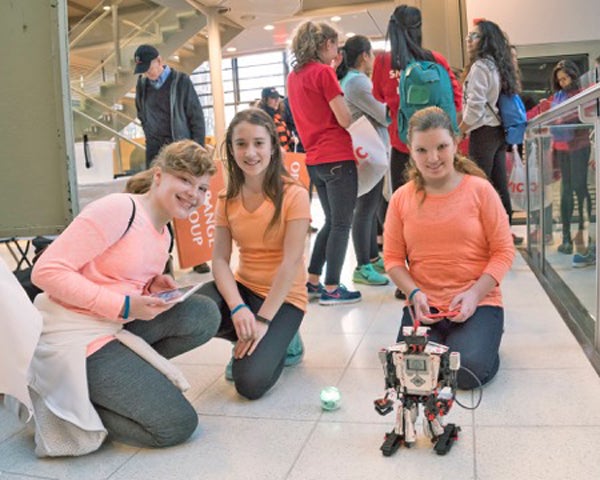 (From left) Posing with a Lego robot at Princeton University’s Frick Chemistry Laboratory are Kelley Davison, Stephanie Frolio and Michelle Frolio, of Fischer Middle School, Ewing Township. (Photo by Elle Starkman/ PPPL Office of Communications)
(From left) Posing with a Lego robot at Princeton University’s Frick Chemistry Laboratory are Kelley Davison, Stephanie Frolio and Michelle Frolio, of Fischer Middle School, Ewing Township. (Photo by Elle Starkman/ PPPL Office of Communications)
Michelle Wong, 14, said, “I was excited to see everybody here who was excited about science, and what I can do in the future.” Giana Stahzione, 14, agreed: “I was most excited about learning about all of the careers I can do.”
Anna Caputo, 14, said that she thinks she wants to be a pharmacist. Science, she explained, has always been her “favorite subject.” Caputo arrived at the Frick Chemistry Laboratory with high expectations: ” I was excited about coming here because I would get a better look at how women found their place in the science field,” she said. “And it’ll help me figure out what I want to do when I’m older, and inspire me to work harder.”
At the conference, Caputo said she discovered something that she won’t forget: “How passionate someone can feel about their career … I feel that it will inspire us to talk and act the same way.” Caputo also felt motivated to go one step further: one day, she hopes to “you know, help others” and “try to inspire other people to go into a certain field — maybe not go into the certain one I’m going into, but just try a different one. Because there’s many different things you can go into with science, so many fields.”
WHYY is your source for fact-based, in-depth journalism and information. As a nonprofit organization, we rely on financial support from readers like you. Please give today.



